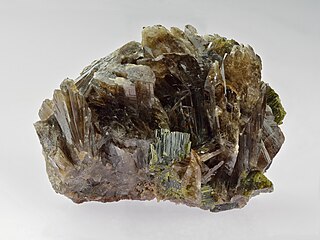
Axinite is a brown to violet-brown, or reddish-brown bladed group of minerals composed of calcium aluminium boro-silicate, (Ca,Fe,Mn)3Al2BO3Si4O12OH. Axinite is pyroelectric and piezoelectric.

Uvarovite is a chromium-bearing garnet group species with the formula: Ca3Cr2(SiO4)3. It was discovered in 1832 by Germain Henri Hess who named it after Count Sergei Uvarov (1765–1855), a Russian statesman and amateur mineral collector. It is classified in the ugrandite group alongside the other calcium-bearing garnets andradite and grossular.

Hausmannite is a complex oxide, or a mixed oxide, of manganese containing both di- and tri-valent manganese. Its chemical formula can be represented as MnIIMnIII2O4, or more simply noted as MnO·Mn2O3, or Mn3O4, as commonly done for magnetite, the corresponding iron oxide. It belongs to the spinel group and forms tetragonal crystals. Hausmannite is a brown to black metallic mineral with Mohs hardness of 5.5 and a specific gravity of 4.8.

Sugilite ( SOO-gə-lyte, -jee-) is a relatively rare pink to purple cyclosilicate mineral with the complex chemical formula KNa2(Fe, Mn, Al)2Li3Si12O30. Sugilite crystallizes in the hexagonal system with prismatic crystals. The crystals are rarely found and the form is usually massive. It has a Mohs hardness of 5.5–6.5 and a specific gravity of 2.75–2.80. It is mostly translucent. Sugilite was first described in 1944 by the Japanese petrologist Ken-ichi Sugi (1901–1948) for an occurrence on Iwagi Islet, Japan, where it is found in an aegirine syenite intrusive stock. It is found in a similar environment at Mont Saint-Hilaire, Quebec, Canada. In the Wessels mine in Northern Cape Province of South Africa, sugilite is mined from a strata-bound manganese deposit. It is also reported from Liguria and Tuscany, Italy; New South Wales, Australia and Madhya Pradesh, India.
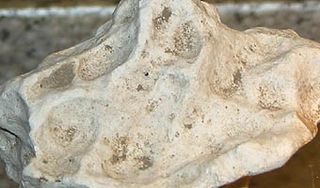
Sepiolite, also known in English by the German name meerschaum ( MEER-shawm, -shəm; German:[ˈmeːɐ̯ʃaʊm] ; meaning "sea foam"), is a soft white clay mineral, often used to make tobacco pipes (known as meerschaum pipes). A complex magnesium silicate, a typical chemical formula for which is Mg4Si6O15(OH)2·6H2O, it can be present in fibrous, fine-particulate, and solid forms.
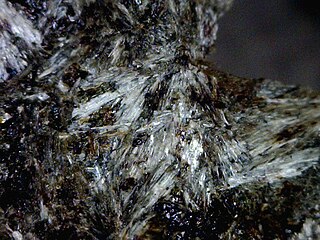
Grunerite is a mineral of the amphibole group of minerals with formula Fe7Si8O22(OH)2. It is the iron endmember of the grunerite-cummingtonite series. It forms as fibrous, columnar or massive aggregates of crystals. The crystals are monoclinic prismatic. The luster is glassy to pearly with colors ranging from green, brown to dark grey. The Mohs hardness is 5 to 6 and the specific gravity is 3.4 to 3.5.

Otwayite, Ni2CO3(OH)2, is a hydrated nickel carbonate mineral. Otwayite is green, with a hardness of 4, a specific gravity of 3.4, and crystallises in the orthorhombic system.
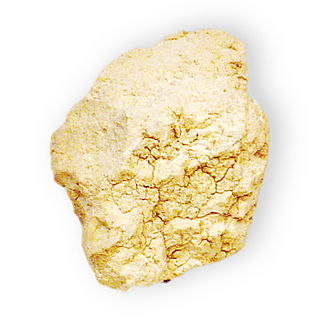
Hectorite is a rare soft, greasy, white clay mineral with a chemical formula of Na0.3(Mg,Li)3Si4O10(OH)2.

Patrónite is the vanadium sulfide mineral with formula VS4. The material is usually described as V4+(S22−)2. Structurally, it is a "linear-chain" compound with alternating bonding and nonbonding contacts between the vanadium centers. The vanadium is octa-coordinated, which is an uncommon geometry for this metal.

Duftite is a relatively common arsenate mineral with the formula CuPb(AsO4)(OH), related to conichalcite. It is green and often forms botryoidal aggregates. It is a member of the adelite-descloizite Group, Conichalcite-Duftite Series. Duftite and conichalcite specimens from Tsumeb are commonly zoned in color and composition. Microprobe analyses and X-ray powder-diffraction studies indicate extensive substitution of Zn for Cu, and Ca for Pb in the duftite structure. This indicates a solid solution among conichalcite, CaCu(AsO4 )(OH), austinite, CaZn(AsO4)(OH) and duftite PbCu(AsO4)(OH), all of them belonging to the adelite group of arsenates. It was named after Mining Councilor G Duft, Director of the Otavi Mine and Railroad Company, Tsumeb, Namibia. The type locality is the Tsumeb Mine, Tsumeb, Otjikoto Region, Namibia.

Matlockite is a rare lead halide mineral, named after the town of Matlock in Derbyshire, England, where it was first discovered in a nearby mine. Matlockite gives its name to the matlockite group which consists of rare minerals of a similar structure.

Shigaite is a mineral with formula NaAl3(Mn2+)6(SO4)2(OH)18·12H2O that typically occurs as small, hexagonal crystals or thin coatings. It is named for Shiga Prefecture, Japan, where it was discovered in 1985. The formula was significantly revised in 1996, identifying sodium as a previously unknown constituent.

Bultfonteinite, originally dutoitspanite, is a pink to colorless mineral with chemical formula Ca2SiO2(OH,F)4. It was discovered in 1903 or 1904 in the Bultfontein mine in South Africa, for which the mineral is named, and described in 1932.
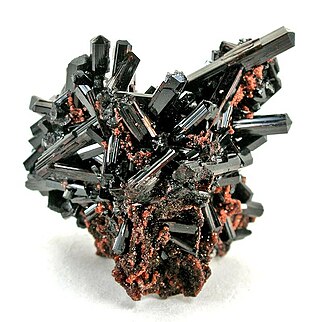
Manganvesuvianite is a rare mineral with formula Ca19Mn3+(Al,Mn3+,Fe3+)10(Mg,Mn2+)2(Si2O7)4(SiO4)10O(OH)9. The mineral is red to nearly black in color. Discovered in South Africa and described in 2002, it was so named for the prevalence of manganese in its composition and its relation to vesuvianite.

Charlesite is a sulfate mineral of the ettringite group. Charlesite was named in 1945 after Dr. Charles Palache mineralogist and professor at Harvard University for his work on minerals. This mineral is extremely rare, and when it is found it is often in crystal form. Its crystals are soft hexagonal, that can vary in color. Colors can range from clear to white, or even a pale yellow or pink. The brittle mineral's Mohs hardness is 2.5 with a specific gravity of 1.79. Though transparent to the eye the mineral has a white streak.

Cyprine is a copper-rich member of the vesuvianite group with the formula Ca19Cu2+(Al10Mg2)Si18O68(OH)10. A similar name is given to a Cu-bearing variety but not Cu-dominant member within the group. Cyprine (sensu stricto) was discovered in the Wessels mine in the vicinity of Hotazel, Kalahari Manganese Field, South Africa.
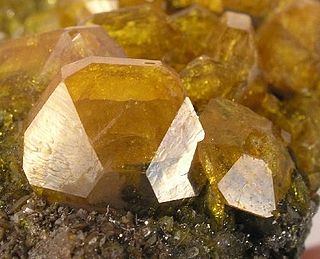
Sturmanite is a rare sulfate mineral with the chemical formula Ca6Fe3+2(SO4)2.5(B(OH)4)(OH)12 · 25 H2O. It crystallises in the tetragonal system and it has a Moh's hardness of 2.5. Sturmanite has a bright yellow to amber colour and falls in the ettringite group. It was named after Bozidar Darko Sturman (born 1937), Croatian-Canadian mineralogist and Curator Emeritus of Mineralogy, Royal Ontario Museum.

Inesite is a hydrous calcium manganese silicate mineral. Its chemical formula is Ca2Mn7Si10O28(OH)2•5(H2O). Inesite is an inosilicate with a triclinic crystal system. It has a Mohs hardness of 5.5 to 6, and a specific gravity of 3.0. Its name originates from the Greek Ίνες (ines), "fibers" in allusion to its color and habit.
Schizolite is a mineral with the formula NaCaMnSi3O8(OH) first described in 1901 after discovery in South Greenland by Winther. Its name comes from the Greek word 'σϗιζω' (sϗizo) after its perfect cleavage. It was dropped from the valid species status in 1955 as a variety of pectolite based on Schaller's work. It's a member of the Wollastonite group.

Lizardite is a mineral from the serpentine subgroup with formula Mg3(Si2O5)(OH)4, and the most common type of mineral in the subgroup. It is also a member of the kaolinite-serpentine group.



















